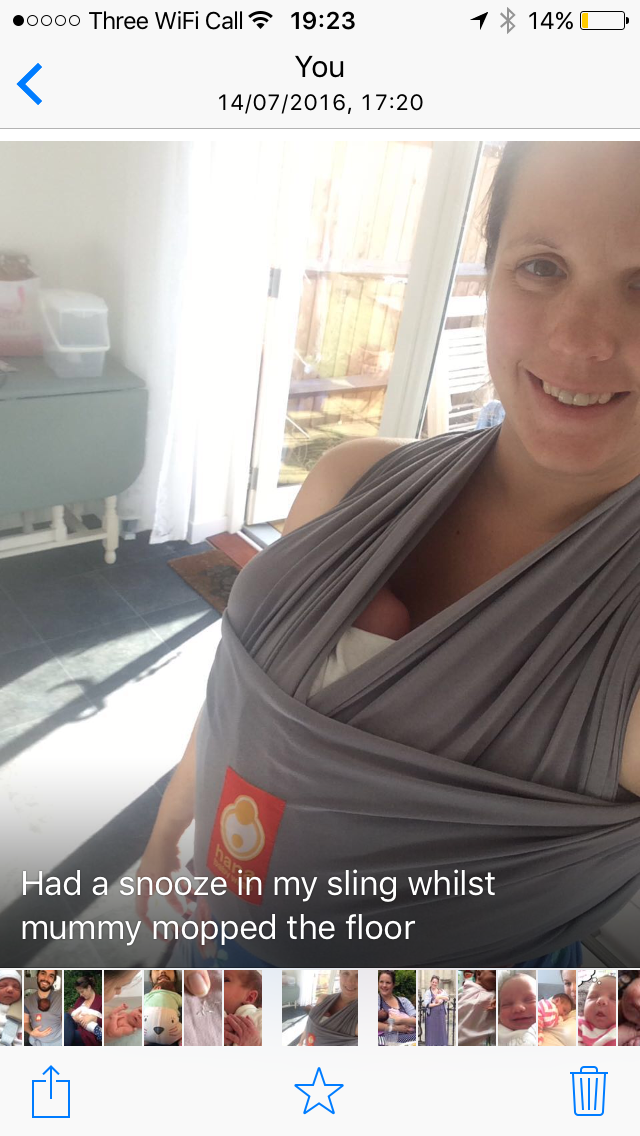Understanding the pattern of infant crying
Catherine Defty of Tactile Tots shares with us some invaluable advice about dealing with a baby's crying pattern. Not only does she share her own personal experience, she shows us that there is light at the end of the tunnel!
Week two into my new life as a mum and like many others this meant Daddy was off back to work and I was discovering a whole new world being at home alone with my precious bundle.
I can’t lie, at this point I thought I was totally bossing it! Being a mum…pah easy stuff. Cleaning the house and feeding myself…no problem with the baby in a sling. Enjoying a pot of tea and cake with my NCT buddies…lovely and so relaxing!
Daddy going back to work was going to be no trouble whatsoever! In fact, I was so confident of this that I sent this message to my family WhatsApp group boasting about mopping the floors on his first day back.
But… and you all knew there was going to be a BUT, this new born bliss was not to last.
Our once contended baby began to cry and cry and cry for hours every day and the only thing that seemed to help was for me to lie on our bed in a darkened room, having skin to skin, with white noise playing and rocking her for hours on end.
She screamed in the pram, which soon became an extremely expensive bag carrier, as I carried her in 30-degree heat. She sobbed in her Moses basket that my mum had lovingly sewn covers for. And well, the side by side cot went empty and unused as she woke the microsecond she was placed in it
We racked our brains desperately searching for what we might be doing wrong. But there didn’t seem to be any particular pattern or cause for the crying. It was often worse in the evenings but that wasn’t a rule. She didn’t really cry overnight. We winded her and massaged her tummy but she didn’t seem to have trapped wind or to be in pain. I tried feeding her, not feeding her but it made no difference. She would just cry. And worse still she only seemed to settle with me or at least I couldn’t bear to hear her cry so wouldn’t let anyone else try for long.
Becoming a parent changes you, so despite my many years of working with children and all my research into colic and the early years, I had forgotten that the information and advice I so happily handed out to new parents, might actually apply to me!
It was at this point that my Health Visitor brain must have finally switched back on (for a moment) and I started looking at the books and research that I would have advised parents to read.
It was then I suddenly realised we had hit the period of PURPLE crying!!
It is actually fairly well researched that all infants experience an increase in crying beginning at around 2 weeks old, peaking at about 6-8 weeks and settling down again at around 12 weeks (or in our case 16!). But it’s not something many people talk about and if they do its usually linked to trying to find medical diagnosis. However, with two nurses in our house we were a 100% confident that there was nothing wrong with our daughter, and although she cried a lot she would always settle, eventually.
It is also recognised in research that not all babies cry the same amount and just because Jim-Bob from your NCT group doesn’t seem to cry at all, it doesn’t mean there is something wrong with your baby. Like us all babies’ personalities differ and as such some are just more sensitive than others.
Interestingly, all infant mammals apparently experience this increase in crying from birth because they are learning about the world around them and how to communicate with it. And I think this is really a key thing, when you start to think of crying as communication it suddenly becomes so much more understandable.
To be honest us Brits are pretty terrible with crying. Whether its crying adults or babies we just don’t like seeing it and will do anything to stop it as fast as we can, with as little fuss as we can! From a young age we are all shushed when we cry (particularly in public) and as adults we hide our faces, if we even cry at all.
However, we all recognise that everyone has the odd bad day, a day were you just feel grumpy, tired or fed up with the world but for some reason we don’t really consider that babies have days like this too. Which means that without the words to express their feelings, babies only way of communicating their bad mood is just to cry.
I’ve always found it useful to think about times when I’ve been crying or even complaining as an adult, often there is very little anyone can do to stop me crying and very rarely can they fix the problem for me. But actually, what I really want is just to have someone to be there and listen to me. To allow me to “let it out” and for some reason after a good cry or rant we often feel much better even when the difficulty remains. Well, babies are the same.
After their immediate needs of food or sleep have been met sometimes there is nothing you can do to stop them crying and the only thing you can do is to be there.
Hold them, cuddle them, tell them you love them and do your best to remain sane whilst you wait for the crying to stop. As with most things in life “this too shall pass” and the period of PURPLE crying will soon a distance memory.
Having said that if you are struggling with your baby’s crying make sure you take a break, put them somewhere safe and have a cup of tea.
Speak to family, friends or health professionals, you do not have to do this alone!
For more support call the CRY-SIS Helpline on 08451 228669
To find out more about Catherine and her business Tactile Tots, visit her website or drop her an email. Alternatively, follow her on Facebook, Instagram or Twitter.



